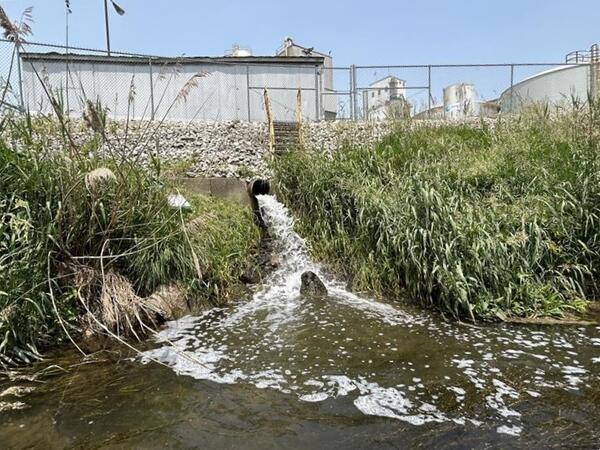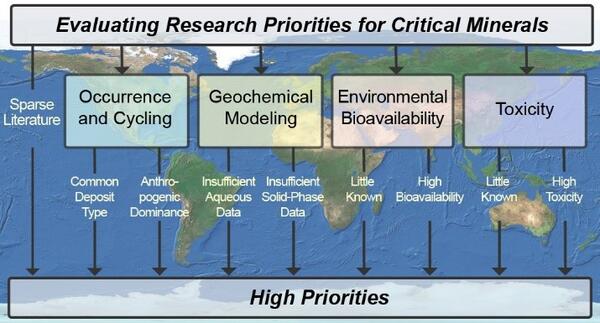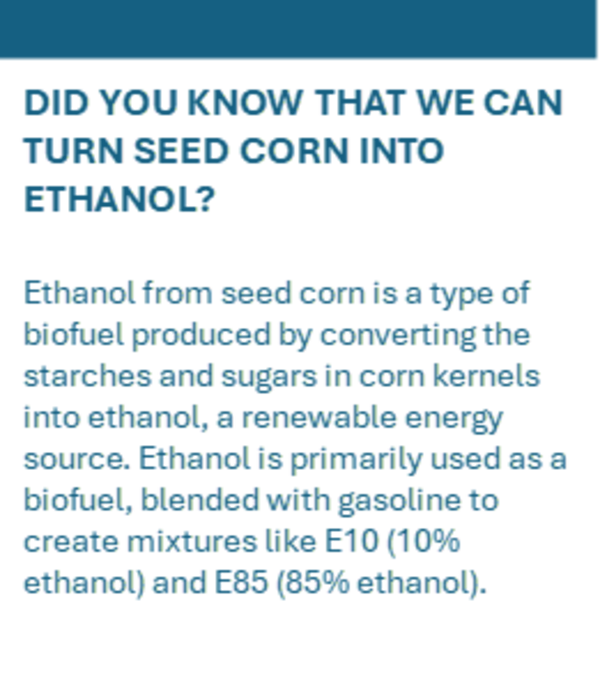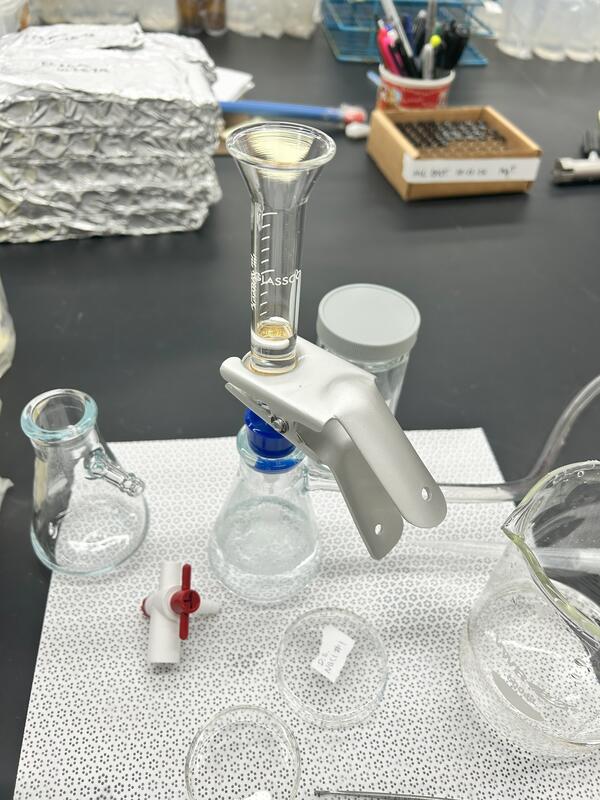Ethanol from seed corn is a type of biofuel produced by converting the starches and sugars in corn kernels into ethanol, a renewable energy source.
Images
All items in this gallery are considered public domain unless otherwise noted.
Ethanol from seed corn is a type of biofuel produced by converting the starches and sugars in corn kernels into ethanol, a renewable energy source.

Treated Wastewater from Soybean Processing Facility
Treated Wastewater from Soybean Processing FacilityEffluent from soybean processing facility following treatment, entering nearby surface water body. Photo taken by USGS, Sandra Leal.
Treated Wastewater from Soybean Processing Facility
Treated Wastewater from Soybean Processing FacilityEffluent from soybean processing facility following treatment, entering nearby surface water body. Photo taken by USGS, Sandra Leal.
America’s diverse ecosystems are an asset to current and future generations by supporting economically and recreationally important fish, wildlife, and lands. Healthy ecosystems support people and nature, fostering prosperity and enjoyment for all.
America’s diverse ecosystems are an asset to current and future generations by supporting economically and recreationally important fish, wildlife, and lands. Healthy ecosystems support people and nature, fostering prosperity and enjoyment for all.
America’s diverse ecosystems are an asset to current and future generations by supporting economically and recreationally important fish, wildlife, and lands. Healthy ecosystems support people and nature, fostering prosperity and enjoyment for all.
America’s diverse ecosystems are an asset to current and future generations by supporting economically and recreationally important fish, wildlife, and lands. Healthy ecosystems support people and nature, fostering prosperity and enjoyment for all.

Multidisciplinary approach to prioritize critical elements for environmental research
Multidisciplinary approach to prioritize critical elements for environmental researchThis infographic introduces an approach that could subsequently be used to prioritize environmental research for the full range of critical elements.
Multidisciplinary approach to prioritize critical elements for environmental research
Multidisciplinary approach to prioritize critical elements for environmental researchThis infographic introduces an approach that could subsequently be used to prioritize environmental research for the full range of critical elements.

Produced‐water management options and potential routes of exposure
Produced‐water management options and potential routes of exposureA general summary of produced‐water management options and potential routes of exposure.
Produced‐water management options and potential routes of exposure
Produced‐water management options and potential routes of exposureA general summary of produced‐water management options and potential routes of exposure.

Rainfall mobilizes roadway contaminants that flow from storm drains into aquatic habitats.
Rainfall mobilizes roadway contaminants that flow from storm drains into aquatic habitats.Rainfall mobilizes roadway contaminants that flow from storm drains into aquatic habitats. Photo taken in the Pacific Northeast
Rainfall mobilizes roadway contaminants that flow from storm drains into aquatic habitats.
Rainfall mobilizes roadway contaminants that flow from storm drains into aquatic habitats.Rainfall mobilizes roadway contaminants that flow from storm drains into aquatic habitats. Photo taken in the Pacific Northeast
Text box including a short question/answer on why microbes are important. Can be used for outreach.
Text box including a short question/answer on why microbes are important. Can be used for outreach.
Q: What’s the difference between PFOS and PFAS?
A: PFAS is a broad term that refers to a large group of man-made chemicals that contain fluorine atoms. This group includes thousands of different compounds and are highly resistant to degradation.
Q: What’s the difference between PFOS and PFAS?
A: PFAS is a broad term that refers to a large group of man-made chemicals that contain fluorine atoms. This group includes thousands of different compounds and are highly resistant to degradation.

Multidisciplinary approach to prioritize critical elements for environmental research.
Multidisciplinary approach to prioritize critical elements for environmental research.This infographic introduces an approach that could subsequently be used to prioritize environmental research for the full range of critical elements.
Multidisciplinary approach to prioritize critical elements for environmental research.
Multidisciplinary approach to prioritize critical elements for environmental research.This infographic introduces an approach that could subsequently be used to prioritize environmental research for the full range of critical elements.

Framework for evaluating research priorities for critical minerals
Framework for evaluating research priorities for critical mineralsMultidisciplinary Approach That Considers Occurrence, Geochemistry, Bioavailability, and Toxicity to Prioritize Critical Minerals for Environmental Research
Framework for evaluating research priorities for critical minerals
Framework for evaluating research priorities for critical mineralsMultidisciplinary Approach That Considers Occurrence, Geochemistry, Bioavailability, and Toxicity to Prioritize Critical Minerals for Environmental Research
This is a photo of a filtration apparatus being used for microplastics analysis, November 2024.
This is a photo of a filtration apparatus being used for microplastics analysis, November 2024.
Dark field microscope from the manuscript, " a) A dark-field image of 1.5 µm PS LMMPs on a 0.4 μm PCTE membrane sensor. b) A Raman map of PS acquired by tracking its Raman band at 996 cm-1
Dark field microscope from the manuscript, " a) A dark-field image of 1.5 µm PS LMMPs on a 0.4 μm PCTE membrane sensor. b) A Raman map of PS acquired by tracking its Raman band at 996 cm-1

USGS scientist working on a high resolution mass spec
USGS scientist working on a high resolution mass specPhoto taken of a USGS scientist working on PFAS analyses in front of her mass spectrometer within a laboratory.
USGS scientist working on a high resolution mass spec
USGS scientist working on a high resolution mass specPhoto taken of a USGS scientist working on PFAS analyses in front of her mass spectrometer within a laboratory.
Cyanobacteria bloom in a shallow Michigan lake during the fall of 2024. Photo by Leon Katona
Cyanobacteria bloom in a shallow Michigan lake during the fall of 2024. Photo by Leon Katona

Copper minerals precipitating along a reach of stream
Copper minerals precipitating along a reach of streamIn streams affected by acid mine drainage, inflows of diffuse groundwater (nearly invisible to the eye) can substantially control metal mobility, such as in this photo where copper minerals are precipitating along a reach of stream where groundwater with a distinctive composition flows into the stream.
Copper minerals precipitating along a reach of stream
Copper minerals precipitating along a reach of streamIn streams affected by acid mine drainage, inflows of diffuse groundwater (nearly invisible to the eye) can substantially control metal mobility, such as in this photo where copper minerals are precipitating along a reach of stream where groundwater with a distinctive composition flows into the stream.

Mineral precipitates in mine tunnels may provide information on the paths of groundwater that discharge into the tunnels
Mineral precipitates in mine tunnels may provide information on the paths of groundwater that discharge into the tunnelsMineral precipitates in mine tunnels, such as the copper-rich minerals in this mine in Oregon, may provide information on the paths of groundwater that discharge into the tunnels, informing strategies for metal recovery and potential remediation.
Mineral precipitates in mine tunnels may provide information on the paths of groundwater that discharge into the tunnels
Mineral precipitates in mine tunnels may provide information on the paths of groundwater that discharge into the tunnelsMineral precipitates in mine tunnels, such as the copper-rich minerals in this mine in Oregon, may provide information on the paths of groundwater that discharge into the tunnels, informing strategies for metal recovery and potential remediation.

ioelectrochemical system for critical mineral recovery from mine byproducts
ioelectrochemical system for critical mineral recovery from mine byproductsLaboratory research: Bioelectrochemical system for critical mineral recovery from mining by-products.
ioelectrochemical system for critical mineral recovery from mine byproducts
ioelectrochemical system for critical mineral recovery from mine byproductsLaboratory research: Bioelectrochemical system for critical mineral recovery from mining by-products.

Tailings piles at abandoned mine sites can be reprocessed to recover critical minerals and rare earth elements
Tailings piles at abandoned mine sites can be reprocessed to recover critical minerals and rare earth elementsTailings piles at abandoned mine sites can be reprocessed to recover critical minerals and rare earth elements.
Tailings piles at abandoned mine sites can be reprocessed to recover critical minerals and rare earth elements
Tailings piles at abandoned mine sites can be reprocessed to recover critical minerals and rare earth elementsTailings piles at abandoned mine sites can be reprocessed to recover critical minerals and rare earth elements.
PFOS removal occurred as sulfate-reducing bacteria increased in soil experiments with a dehalogenating culture. Graphic Credits: Denise Akob
PFOS removal occurred as sulfate-reducing bacteria increased in soil experiments with a dehalogenating culture. Graphic Credits: Denise Akob

Cyanobacteria bloom near the shoreline of North Bar Lake in Sleeping Bear Dunes National Lakeshore, Michigan
Cyanobacteria bloom near the shoreline of North Bar Lake in Sleeping Bear Dunes National Lakeshore, MichiganCyanobacteria bloom near the shoreline of North Bar Lake in Sleeping Bear Dunes National Lakeshore, Michigan during the fall of 2024.
Cyanobacteria bloom near the shoreline of North Bar Lake in Sleeping Bear Dunes National Lakeshore, Michigan
Cyanobacteria bloom near the shoreline of North Bar Lake in Sleeping Bear Dunes National Lakeshore, MichiganCyanobacteria bloom near the shoreline of North Bar Lake in Sleeping Bear Dunes National Lakeshore, Michigan during the fall of 2024.










